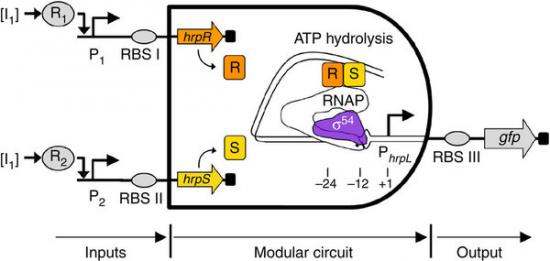英国研究人员最近用细菌和基因手段开发出一种可模块化的新型“生物逻辑门”,为研制生物计算机铺平道路。

逻辑门是计算机的基础,它是一种对输入的信息进行逻辑运算,然后输出信息的装置。通过对不同逻辑门进行各种组合,就可搭建出复杂的计算机电路。
英国帝国理工学院研究人员在新一期《自然·通信》杂志上报告说,新型“生物逻辑门”是通过对一种无害的大肠杆菌进行基因改造而实现,即用蛋白质等作为输入信息和输出信息,完成逻辑运算,从而具有与当前计算机所用电路逻辑门类似的信息处理能力。
更重要的是,这种“生物逻辑门”可以模块化地进行逻辑门之间的叠加。而以前虽然也有一些研究实现了“生物逻辑门”,但缺少这种模块化叠加的功能,因此本次研究成果是迄今最先进的。
论文共同作者理查德·凯特利教授说,接下来将尝试用这种方法构建更复杂的逻辑回路,希望能在此基础上开发出新一代的生物处理器,并最终研制出功能强大的生物计算机。
相关英文论文摘要:
Engineering modular and orthogonal genetic logic gates for robust digital-like synthetic biology
Modular and orthogonal genetic logic gates are essential for building robust biologically based digital devices to customize cell signalling in synthetic biology. Here we constructed an orthogonal AND gate in Escherichia coli using a novel hetero-regulation module from Pseudomonas syringae. The device comprises two co-activating genes hrpR and hrpS controlled by separate promoter inputs, and a σ54-dependent hrpL promoter driving the output. The hrpL promoter is activated only when both genes are expressed, generating digital-like AND integration behaviour. The AND gate is demonstrated to be modular by applying new regulated promoters to the inputs, and connecting the output to a NOT gate module to produce a combinatorial NAND gate. The circuits were assembled using a parts-based engineering approach of quantitative characterization, modelling, followed by construction and testing. The results show that new genetic logic devices can be engineered predictably from novel native orthogonal biological control elements using quantitatively in-context characterized parts.
英文论文链接:https://www.biodiscover.com/news/bioinformatics/library/1662







